

Able Research. Winners of the Ig® Nobel Prize For achievements that first make people LAUGH then make them THINK "The Ig Nobel awards are arguably the highlight of the scientific calendar.
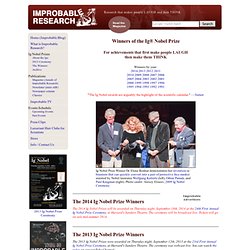
" —Nature ImprobableAdvertisers The 2014 Ig Nobel Prize Winners The 2014 Ig Nobel Prizes will be awarded on Thursday night, September 18th, 2014 at the 24th First Annual Ig Nobel Prize Ceremony, at Harvard's Sanders Theatre. The 2013 Ig Nobel Prize Winners The 2013 Ig Nobel Prizes were awarded on Thursday night, September 12th, 2013 at the 23rd First Annual Ig Nobel Prize Ceremony, at Harvard's Sanders Theatre. MEDICINE PRIZE: Masateru Uchiyama [JAPAN], Xiangyuan Jin [CHINA, JAPAN], Qi Zhang [JAPAN], Toshihito Hirai [JAPAN], Atsushi Amano [JAPAN], Hisashi Bashuda [JAPAN] and Masanori Niimi [JAPAN, UK], for assessing the effect of listening to opera, on heart transplant patients who are mice.
ATTENDING THE CEREMONY: Masateru Uchiyama, Xiangyuan Jin, Masanori Niimi. List of Ig Nobel Prize winners. Drawing Lessons. Drawspace Pro Lessons are designed for artists of all levels and educators, and are logically organized into resources and activities.
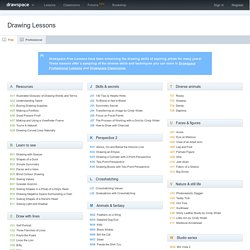
Eventually, all lessons and E-books authored by Brenda Hoddinott will be available here: four to eight brand new lessons and newly-revised older lessons are being added every month! Upgrade Now: Download all 310 lessons and 4 e-books! Try for Free: Download lessons marked as "Free"! 1.1.R1 Glossary Of Art Terms Definitions of art-related terms used in the resources and activities of Drawspace Curriculum (updated February 2013) $3.99or Upgradeto access all files 1.1.R2 Travelling Back in Time with Graphite A few fun tidbits of information about the history of graphite $0.99or Upgradeto access all files 1.1.R3 Examining Graphite and Grades Understanding the differences between H and B grades of graphite $0.99or Upgradeto access all files 1.1.R4 Seeing Grades in Drawings.
Microbial electrolysis cell.png. Soil inoculant. Research into the benefits of inoculants in agriculture extends beyond their capacity as biofertilizers.
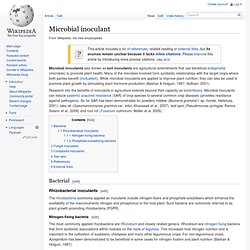
Microbial inoculants can induce systemic acquired resistance (SAR) of crop species to several common crop diseases (provides resistance against pathogens). So far SAR has been demonstrated for powdery mildew (Blumeria graminis f. sp. hordei, Heitefuss, 2001), take-all (Gaeumannomyces graminis var. tritici, Khaosaad et al., 2007), leaf spot (Pseudomonas syringae, Ramos Solano et al., 2008) and root rot (Fusarium culmorum, Waller et al. 2005). Bacterial[edit] Rhizobacterial inoculants[edit] The rhizobacteria commonly applied as inoculants include nitrogen-fixers and phosphate-solubilisers which enhance the availability of the macronutrients nitrogen and phosphorus to the host plant.
Nitrogen-fixing bacteria[edit] The most commonly applied rhizobacteria are Rhizobium and closely related genera. Probiotic. Élie Metchnikoff first suggested the possibility of colonizing the gut with beneficial flora in the early 20th century.
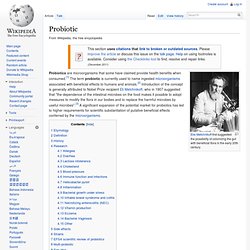
Probiotics are microorganisms that some have claimed provide health benefits when consumed.[1] The term probiotic is currently used to name ingested microorganisms associated with beneficial effects to humans and animals.[2] Introduction of the concept is generally attributed to Nobel Prize recipient Eli Metchnikoff, who in 1907 suggested that "the dependence of the intestinal microbes on the food makes it possible to adopt measures to modify the flora in our bodies and to replace the harmful microbes by useful microbes".[3] A significant expansion of the potential market for probiotics has led to higher requirements for scientific substantiation of putative beneficial effects conferred by the microorganisms. AquAdvantage salmon. Aquaculture[edit] Commercial aquaculture is the most rapidly growing segment of the agricultural industry, accounting for more than 60 million tons in 2012, versus 90 million tons of wild caught fish.
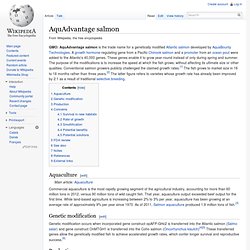
That year, aquaculture output exceeded beef output for the first time. While land-based agriculture is increasing between 2% to 3% per year, aquaculture has been growing at an average rate of approximately 9% per year since 1970. As of 2011, Salmon aquaculture produced 1.9 million tons of fish. Genetic modification[edit] Genetic modification occurs when incorporated gene construct opAFP-GHc2 is transferred into the Atlantic salmon (Salmo salar) and gene construct OnMTGH1 is transferred into the Coho salmon (Oncorhynchus kisutch) These transferred genes allow the genetically modified fish to achieve accelerated growth rates, which confer longer survival and reproductive success.[6]
Fecal bacteriotherapy. Previous terms for the procedure include fecal bacteriotherapy, fecal transfusion, fecal transplant, stool transplant, fecal enema and human probiotic infusion (HPI).
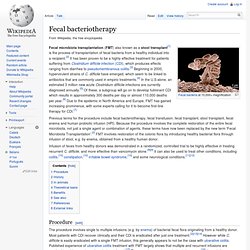
Because the procedure involves the complete restoration of the entire fecal microbiota, not just a single agent or combination of agents, these terms have now been replaced by the new term 'Fecal Microbiota Transplantation'.[2] FMT involves restoration of the colonic flora by introducing healthy bacterial flora through infusion of stool, e.g. by enema, obtained from a healthy human donor. Infusion of feces from healthy donors was demonstrated in a randomized, controlled trial to be highly effective in treating recurrent C. difficile, and more effective than vancomycin alone.[8][9] It can also be used to treat other conditions, including colitis,[10] constipation,[10] irritable bowel syndrome,[10] and some neurological conditions.[11][12]